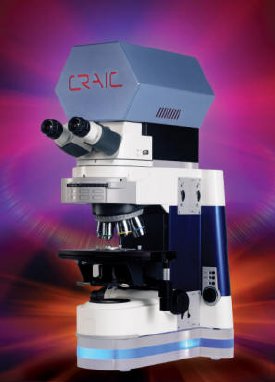Organic and inorganic contaminants of precision devices such as flat panel displays, MEMS devices and patterned semiconductors are often difficult to detect. Many contaminant materials are essentially invisible to common analytical techniques such as optical microscopy.
 The QDI 2010 from CRAIC Technologies.
The QDI 2010 from CRAIC Technologies.
CRAIC Technologies, Inc., a global leader in application-focused microanalysis solutions, provides the capability to both detect and analyze trace contaminants with a single instrument. This is done by combining both ultraviolet microscopy with ultraviolet microspectroscopy in the CRAIC Technologies QDI 2010™ microspectrophotometer equipped with the optional QDI ImageUV™ package.
Many organic and inorganic materials absorb light in the ultraviolet region but are invisible to the naked eye. This means that standard optical microscopy will not be able to detect these contaminants nor is it capable of analyzing them. While other techniques are available, they require extensive sample preparation and can damage the sample. By utilizing ultraviolet micro-imaging, the user is able to quickly, easily and non-destructively locate many contaminants. UV microspectroscopy can then be performed to measure the electronic spectral characteristics of the contaminant in order to identify it. The spectra can also be used to further improve the clarity of the image of the contaminants by determining the wavelength of maximum absorbance. By combining both techniques in the QDI 2010™ microspectrophotometer, the user is easily able to locate and identify contaminant materials on flat panel displays, semiconductor chips, MEMS and even microfluidic devices. The QDI 2010™ microspectrophotometer is the first system ever to combine both UV microscopy and microspectroscopy in a single tool. It can also be upgraded to enable ultraviolet, visible and near infrared reflectance, transmittance and fluorescence microscopy and microspectroscopy.